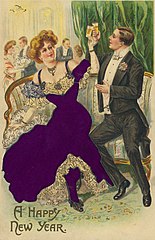
January is a month of new beginnings. In past years that meant making life-improving resolutions to exercise, or become more organized, or de-clutter. Any or all of these activities are tied to an overall concept of happiness, sometimes defined a the state of being happy. Similar to: contentment, pleasure, satisfaction, cheerfulness.
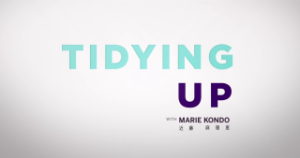
Last year the guru of happiness was Marie Kondo with her KonMari system of de-cluttering our way to happiness. Many of us practiced her system while in quarantine in 2020. We asked each possession if it gave us joy, and cleared our lives of everything didn’t give us happiness. Does that mean everything that didn’t get thrown out makes us happy? I hope so. If not, maybe it just needs the right container, in which case Marie has teamed up with the Container Store to provide it.
But, I digress. The point is, we can’t do our new year organizational projects, because we did them all last year. Consequently, as we end the first month of 2021, many of us are ready to try hygge, a lifestyle concept practiced in Denmark, the country that consistently achieves the status of being one of the happiest countries in the world.*
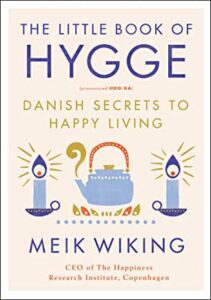
Meik Wiking, founder and CEO of the Happiness Research Institute in Copenhagen, shared Danish hygge with the world in his 2016 The Little Book of Hygge. Wiking’s advice took off, and the word hygge was a 2016 finalist for Oxford Dictionaries Word of the Year.**
Hygge, pronounced hoo-guh, is related to the Norwegian word, hugga, meaning to comfort or console. Hygge describes the art of being snug, comfortable, and content in yourself. It is a simple lifestyle of cozy nooks, flickering flames, warm drinks, and good friends—socially distanced, of course.
Ingredients of a Hygge Life
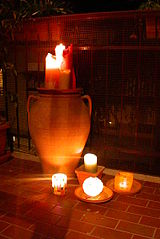
Candles and firelight are important. They give the room a warm glow as well as increasing a room’s temperature. Americans tend to worry about the fire hazard candles can pose. The Danes burn 13 pounds of candle wax per person, per year.
Textiles add to the atmosphere, either as nubby sweaters and thick socks, or soft throw blankets to snuggle under. Snuggling can be done within your quarantine bubble, as you nibble home made popcorn and watch happy films. [Yes, I know, you’ve been doing that for months that seem like years, but did you also light candles?]
By the way, you know those comfy sweatpants you like to wear around the house? Those are hyggebusker.
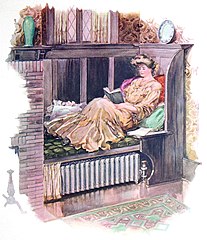
Reading is also a good hygge activity, espcially in a designated nook with a bit of light, a blanket tossed over your knees to keep out the chill, and a mug of tea to warm your hands.
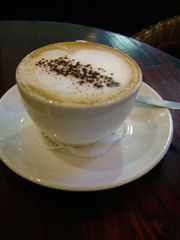
Mindful, indulgent food and drink are also part of hygge. Dinner in the slow cooker, coffee, tea, or hot chocolate, pastries or chocolate cake — all contribute to a sense of well-being. For example, enjoying a special cup of spiced coffee is bound to infuse a sense of contentment.
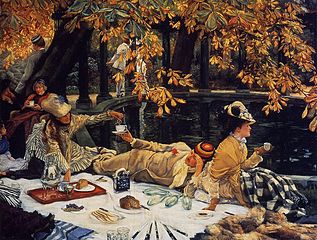
In these interesting times, it might be easy to confuse hygge with self-quarantine. That would be a mistake. Hygge is a social practice with intimate friends. Long, chilly walks with friends on chilly days followed by a picnic out of the wind is a lovely way to practice Hygge, as soon as we get out of quarantine.
At the moment, much of Hygge is confined to our homes. One person’s advice on creating a hygge home is in this 6 minute video, but you already know what to do. Hygge is life in the slow lane. Stop, breathe, inhale that coffee aroma, and curl up in a warm nook with a good book.
*In 2020 The Gallup World Happiness Report rated Denmark as the second happiest country in the world, after Finland.
** The 2016 Oxford Dictionaries Word of the year was post-truth, adjective, “relating to or denoting circumstances in which objective facts are less influential in shaping public opinion than appeals to emotion and personal belief.” [Languages.OUP]
🔥🔥🔥
Illustrations
A Happy New Year, 2009 Postcard
Tidying Up Logo
Candles
Woman Reading in a Cozy Nook. 1905 American Radiator Company Catalog
Coffee with Spices by Lotus Head
Holyday. James Tissot. 1876
Anna Altman. “The Year of Hygge.” New Yorker. Dec. 18, 2016.
Lyndsey Matthews. “What is Hygge?” Country Living. Dec. 4, 2018.

Sandra Wagner-Wright holds the doctoral degree in history and taught women’s and global history at the University of Hawai`i. Sandra travels for her research, most recently to Salem, Massachusetts, the setting of her new Salem Stories series. She also enjoys traveling for new experiences. Recent trips include Antarctica and a river cruise on the Rhine from Amsterdam to Basel.
Sandra particularly likes writing about strong women who make a difference. She lives in Hilo, Hawai`i with her family and writes a blog relating to history, travel, and the idiosyncrasies of life.

